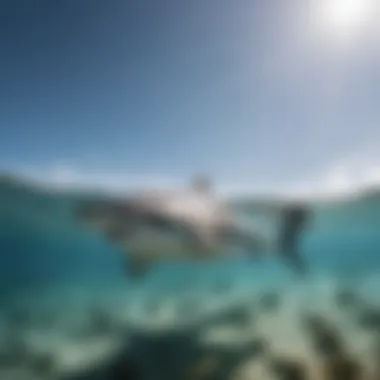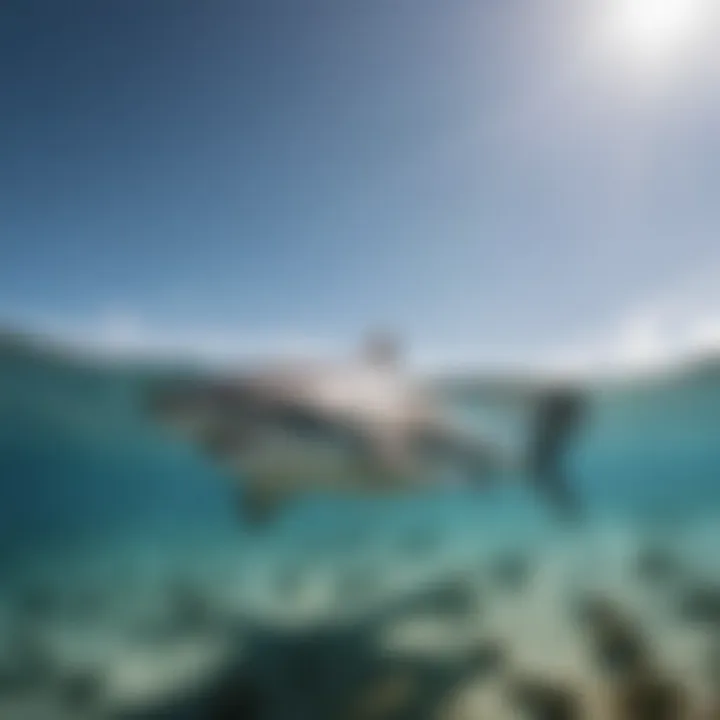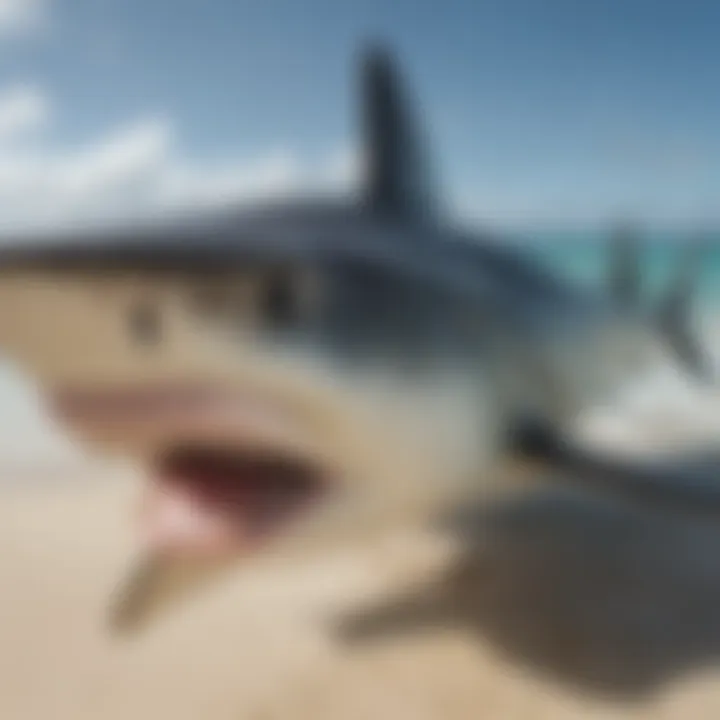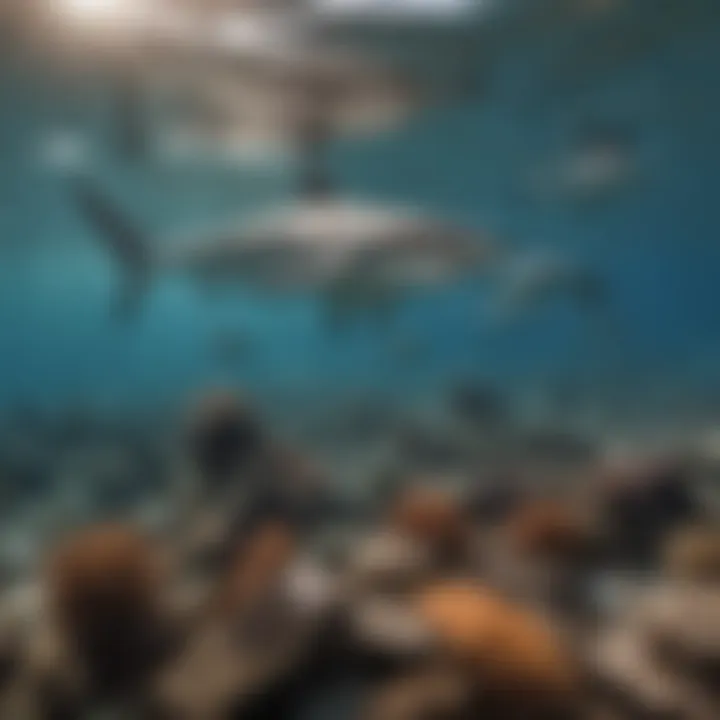A Comprehensive Guide to Shark Websites


Intro
The online world offers a treasure trove of resources dedicated to sharks, which, surprisingly, tend to get the short end of the stick in discussions about marine life. While whales and dolphins often hog the spotlight, these apex predators are just as vital to the health of ocean ecosystems. They play a crucial role in maintaining the balance of marine life, acting as a check on fish populations and helping to maintain the health of coral reefs. Understanding sharks goes beyond mere fascination—it's essential for promoting their conservation and debunking the myths that tend to suffocate public opinion.
This guide aims to steer the curious reader through a carefully curated landscape of websites focused on shark studies, range of educational platforms, and conservation efforts. We’ll examine not only the facts but also the ways these resources can enrich the knowledge of enthusiasts, researchers, and the general public alike.
By diving deep into the subject matter, we hope to foster an understanding that extends far beyond sensational headlines. So, let's explore what the internet has to offer in terms of reliable information and impactful initiatives that support the world's sharks.
The Importance of Accurate Information
Sharks are often painted in a negative light, often due to sensationalist media portrayals. Informing the general public about their ecological importance and unique behaviors can significantly aid conservation efforts. Misinformation can lead to fear and misunderstanding, directly impacting shark populations through misguided practices.
Educational websites, documentaries, and online forums serve as powerful tools in combating these myths. They present a platform for sharing scientifically-backed information, which could pave the way for greater appreciation and respect for sharks. This is where having accurate information becomes paramount.
"The shark in the ocean is often likened to a lion in the jungle—both misunderstood and, in many cases, under-appreciated creatures essential to their ecosystems."
Through this guide, we aim to synthesize trustworthy resources equipped to educate and inspire.
Gear Essentials
As enthusiasts in marine conservation, the right tools make all the difference when delving into shark studies or even when enjoying water sports that allow for close interactions with these magnificent creatures.
Top Picks for Shark-Related Research Tools
While most of us may picture diving gear when discussing tools related to sharks, we can't overlook the tech that elevates the research. Here’s a quick list of notable equipment:
- High-Resolution Underwater Cameras: Capture stunning images and videos of sharks in their natural habitat.
- Sonar Equipment: Used for mapping underwater structures and studying shark movements.
- Drones: Perfect for aerial surveillance, helping in tracking large schools of sharks.
- Field Guides: Handy references that provide information on different species and their behaviors.
Maintenance and Care Tips for Gear
Taking care of your gear is just as important as choosing the right tools. For longevity and effectiveness:
- Rinse equipment in freshwater after use in the ocean to prevent salt build-up.
- Store in a dry, cool place to avoid any mold or corrosion.
- Regularly check and replace batteries in any electronic devices.
Engaging with sharks through underwater exploration demands respect—for the creatures themselves and the tools we benefit from, ensuring both operate smoothly.
A Call to Action
The digital age provides unique opportunities for enhancing awareness about sharks. By engaging with reputable sites and platforms dedicated to their study and conservation, we not only enrich our own knowledge but contribute to a larger movement advocating for the continued survival of sharks. It’s this understanding and advocacy that can create ripple effects throughout ecosystems.
Continuing this journey, we will explore various educational resources that provide in-depth information on our ocean's sharks, thus solidifying our collective responsibility in ensuring their survival.
Prelims to Shark Conservation
Shark conservation is not just a niche topic in marine biology; it’s crucial to understanding our oceans’ ecological health. The mere presence of sharks in our waters is evidence of a balanced marine ecosystem. As apex predators, they play a pivotal role in maintaining the structure and balance of marine life. Without them, we risk a domino effect that could disrupt entire marine communities, resulting in a loss of biodiversity and jeopardizing other species, including those important to fisheries.
Sharks help control populations of prey species, which in turn keeps various marine ecosystems healthy. Their absence could lead to overpopulation of certain fish and other marine animals, resulting in overcrowded habitats and potential extinction of species that can’t compete for resources. Understanding this dynamic is a key aspect that this article addresses; it brings to light the interconnections within marine environments and emphasizes the necessity of sharks in those systems.
The implications of conserving sharks extend beyond ecological benefits. Promoting shark conservation is also about preserving cultural heritage, supporting local economies through eco-tourism, and ensuring that future generations inherit a vibrant marine ecosystem. Knowledge about these aspects serves as a driving force behind initiatives that aim to protect shark populations globally.
The Ecological Role of Sharks
The importance of apex predators
Apex predators like sharks are often termed the guardians of the sea. Their presence is integral in controlling species populations at various trophic levels. This intrinsic quality helps regulate prey species such as smaller fish and prevents them from overfeeding on marine vegetation. A healthy balance fosters a diverse underwater world, which is not just good for sharks but essential for all marine life. In conservation conversations, highlighting apex predators emphasizes the broader message of biological interdependence.
Sharks also evolve adaptations for hunting that help them be efficient in their ecological roles. An example is the great white shark, recognized for its speed and agility, allowing it to predate effectively. This characteristic makes it a choice subject in conservation education, helping to underline the complexities of oceanic ecosystems.
The impact on marine biodiversity
The impact of sharks on marine biodiversity cannot be overstated; they help maintain the balance of species, thus promoting healthy ecosystems. For instance, through selective predation, sharks remove sick or weaker individuals from prey populations. This natural process supports the evolution of stronger species, contributing to genetic diversity within marine ecosystems.
Moreover, healthy shark populations correlate with robust coral reef systems. The removal of sharks often leads to algal overgrowth, which can smother corals and alter entire habitats. Understanding this interlinked relationship is crucial as it showcases not just the ecological but also the socio-economic repercussions of declining shark populations; healthier oceans mean healthier fishing industries, which brings benefits to coastal communities.
Threats Facing Shark Populations
Overfishing and bycatch
One of the most pressing issues sharks face is overfishing. Their slow maturation and low reproductive rates make sharks particularly vulnerable to population decline. The practice of bycatch, where sharks are inadvertently caught in nets and hooked while targeting other fish, exacerbates this issue. It is estimated that a significant percentage of sharks caught annually are bycatch, which raises alarms about their long-term survival.
Overfishing not only threatens individual shark species but also destabilizes the marine ecosystems they help to maintain. This situation creates a ripple effect on biodiversity and food webs within the ocean. The urgent call for responsible fishing practices is often correlated with these statistics, highlighting the need for change among fishing industries.
Habitat loss and climate change
The dual threats of habitat loss and climate change loom large over shark populations. Coastal development and pollution diminish essential habitats like nurseries in mangroves and seagrass beds. Young sharks often rely on these sheltered areas as a safe haven to grow and thrive. Without these habitats, juvenile sharks face increased risks from predation and harsher environmental conditions.
Additionally, climate change has far-reaching consequences. Increased ocean temperatures and acidification can affect shark physiology and reproductive success. As temperatures rise, prey availability shifts, which forces sharks to adapt or relocate. These changes not only impact shark populations but also the myriad species they interact with and the overall health of marine ecosystems.
"Protecting sharks is protecting the future of our oceans. Without them, we lose much more than a single species; we lose a crucial piece of oceanic stability."
The narrative of shark conservation is complex, woven with the threads of ecological science and urgent ethical calls. By exploring these various aspects of shark conservation, we can deepen understanding, encourage informed discussions, and foster a stronger commitment to preserving these magnificent creatures.
Educational Platforms on Sharks
Educational platforms focusing on sharks serve a crucial role in promoting awareness and understanding of these majestic creatures. Such platforms offer various educational resources, ensuring that individuals from all walks of life can engage with marine conservation concepts. The benefits range from flexible learning to interactive experiences, allowing for a deeper appreciation of sharks and the marine ecosystems they inhabit. These resources are not merely academic; they help cultivate a more informed public, ultimately leading to increased advocacy for shark conservation efforts.
Online Courses and Webinars
Online courses and webinars present a unique opportunity for individuals, regardless of their location, to learn about sharks from the comforts of their homes. They cater to various interests and knowledge levels, making them highly accessible.
University-led programs


University-led programs are often the gold standard in marine education, providing a comprehensive curriculum that covers everything from basic shark biology to complex ecological systems. A key characteristic of these programs is their academic rigor, often backed by extensive research and expert faculty. This makes them a beneficial choice for those serious about understanding sharks.
One of the unique features of university-led courses is their emphasis on hands-on research opportunities. Students might even get the chance to participate in real-life field studies or conservation projects. However, they may come with a significant financial investment, which could be a drawback for some individuals.
Expert-led seminars
Expert-led seminars differ from university programs in that they're usually shorter and more focused on topical issues. They offer insights directly from professionals in the field, be it biologists, conservationists, or even filmmakers. The interactive nature of these seminars makes them appealing for individuals who thrive in engaging environments.
These seminars often cover emerging research and conservation strategies that are crucial for anyone interested in sharks today. However, their brief nature means that deep learning may be limited, relying heavily on the background knowledge of the participants.
Interactive Learning Resources
Interactive learning resources are a realm where education meets technology, capturing the attention of enthusiasts and providing invaluable learning experiences. This segment of education allows individuals to explore shark-related content in an engaging way.
Virtual aquariums and research databases
Virtual aquariums and research databases are incredible tools for learning. These platforms provide immersive experiences that allow users to explore marine environments and observe sharks in near-real life scenarios. Their key characteristic is the blend of interactive technologies that bring educational materials to life.
A standout feature is how many of these resources offer real-time data on shark populations and behaviors, making them applicable for educational and research purposes. However, some users could find the interface complex, requiring a bit of a learning curve to maximize the educational value.
Documentaries and interviews
Documentaries and interviews serve as a window into the lives of sharks, often showcasing their plight in a visually compelling manner. They provide a key characteristic of storytelling—making science accessible and engaging through narrative. Many documentaries also feature interviews with experts and conservationists, shedding light on current shark issues.
A distinct advantage of this kind of content is its ability to reach a broad audience, including those who might not usually engage with scientific material. However, often these productions can oversimplify complex topics, which may lead to misconceptions if viewers are not careful.
"Interactive experiences make learning mer elusive and enjoyable, giving everyone a stake in shark conservation."
In summary, educational platforms focusing on sharks are essential for delving into this fascinating area of marine biology. With various formats available, from university programs to interactive resources, there's sure to be something for everyone interested in sharks.
Notable Shark Conservation Organizations
Shark conservation organizations play a vital role in safeguarding these majestic creatures and advocating for sustainable marine practices. These groups are active in raising awareness, conducting research, and implementing practical initiatives that directly influence shark populations globally. The importance of their work cannot be understated, as the balance of marine ecosystems hinges heavily on the viability of shark species.
Organizations like the Marine Conservation Society and Shark Trust unearth significant insights into the challenges facing sharks while creating pathways toward effective conservation solutions. They engage not just researchers or policymakers but also enthusiasts, recreational water users, and the broader public. Here’s how they operate.
Marine Conservation Society
Programs and initiatives
The Marine Conservation Society is known for its robust programs and initiatives aimed at preserving marine life, including sharks. One shining example is their community-focused shark conservation efforts that actively involve local populations in monitoring and protecting shark habitats. Their educational outreach equips communities with tools and knowledge to foster environmental stewardship. Key characteristics of these programs include inclusivity and adaptability, as they are tailored for various age groups and skill levels.
An attractive aspect of these programs is their innovative approach to involving citizens in scientific data collection. By training volunteers to help with monitoring shark populations, they not only gather valuable data but also ignite a passion for marine science among participants.
While there are many positives, the challenge lies in ensuring that the general public feels adequately empowered to contribute, which can sometimes be a barrier. The society emphasizes building trust and ongoing support, creating a ripple effect in conservation efforts.
Partnerships and collaborations
Collaborating with schools, other nonprofits, and research institutions, the Marine Conservation Society develops partnerships that enhance their impact. These collaborations amplify their reach and facilitate knowledge sharing among various stakeholders in conservation. With a network of like-minded organizations, they've pushed forward initiatives that lead to policy changes regarding shark legislation.
The unique feature of their partnerships is their strategic approach to uniting efforts under common goals. For instance, joint campaigns often include combined resources for better outreach and conservation cost-efficiency.
However, the challenge of aligning different institutional goals can create friction. Despite potential hiccups, the benefits of pooling resources typically yield considerable long-term benefits.
Shark Trust
Advocacy and education
In the realm of shark conservation, the Shark Trust stands as a formidable advocate. Their commitment to education and outreach is exemplary. They design educational resources that enlighten various demographics about the significance of sharks within connoting societal misguided perceptions.
A key aspect is their use of creative education strategies, such as interactive workshops and digital media campaigns that resonate deeply with younger audiences. This engages the community in a way that merely presenting facts might not achieve. The various educational pamphlets, online resources, and local events they host foster a genuine interest in marine conservation.
While their initiatives are mainly beneficial, keeping the messaging fresh and compelling can prove to be an ongoing challenge in a world where attention spans are short.
Research and policy influence
Another crucial dimension of the Shark Trust's work is their involvement in research and policy influence. Collaborating with scientists, they collect critical data that shapes the future of shark management policies. Their advocacy goes beyond just awareness; it dives into the legislative waters as well, promoting science-based policies that enhance shark protection statuses.
The characteristic feature of their research efforts is the close partnership with governmental bodies and international organizations. This synergy helps translate research findings into actionable policy changes that can lead to tangible protections for sharks.
Nevertheless, gaining traction for policy changes can often come with hurdles, especially in areas where shark populations aren't as high on the priority list. Yet, the sustained efforts of the Shark Trust keep the conversation alive, bridging the gap between research and real-world application.
"Sharks are not just powerful apex predators. They are crucial in maintaining the delicate balance of ocean ecosystems."
The work of these notable organizations exemplifies the significant role that collaboration, education, and advocacy play in fostering a healthy consicousness towards sharks. Safety, conservation, and awareness combined pave the way for a brighter future for these essential marine allies.
Popular Websites Focusing on Sharks
Websites devoted to sharks serve a vital role in educating the public and creating awareness about these fascinating creatures. They act like a bridge, connecting the scientific community with enthusiasts, be they casual beachgoers or seasoned marine biologists. The information provided on these platforms ranges from scientific research to practical conservation tips, catering to various audiences. Furthermore, these sites foster a sense of community among individuals passionate about marine life, encouraging interaction through forums and social media integration.
National Geographic
National Geographic has established itself as a reliable source of knowledge in many realms, including marine biology and shark conservation.
Articles and updates
National Geographic's articles and updates focus on cutting-edge research and evolving ecological themes, which are crucial for keeping the audience informed. They frequently publish articles that cover new shark species discoveries, marine ecosystem dynamics, and conservation strategies. These engaging articles often feature persuasive storytelling, making science accessible and appealing.
A key characteristic that sets National Geographic apart is its ability to present complex scientific ideas in a manner that is not overly technical. The articles appeal to a broad audience, from conservationists to general readers interested in marine life. This distinctive ability enhances the site's role as a pivotal resource in promoting shark awareness.
However, the articles can sometimes delve into specialized jargon that may alienate readers without a scientific background. People might find themselves needing supplementary resources to fully understand intricate studies or terminology.
Multimedia resources
The multimedia resources provided by National Geographic complement its written content effectively. Through interactive maps, videos, and mesmerizing photography, users can journey through underwater environments and witness sharks in their natural habitats without getting wet.


The visual storytelling that multimedia resources offer forms a connection that text alone often cannot achieve. For enthusiasts, these resources can transform static information into dynamic experiences, enriching their understanding and appreciation.
Nevertheless, due to the nature of multimedia content, it might not always be available in languages other than English, which can limit accessibility for non-English speaking audiences. This can be a drawback for a truly global outreach.
Oceana
Oceana's work is firmly rooted in activism, focusing on protecting ocean ecosystems while highlighting the essential role sharks play within them. Their approach is both educational and engaging, providing vital information and compelling reasons for conservation efforts.
Campaigns and educational content
Oceana excels in running campaigns that draw attention to critical issues threatening shark populations. Their educational content is not just informative but also urges readers to take action. By focusing on practical conservation methods, such as advocating for better fishing policies and creating marine protected areas, Oceana stands out as an impactful choice for learning about and supporting shark conservation.
The strong emphasis on community involvement is a unique aspect of their campaigns, allowing ordinary individuals to feel empowered in the fight against shark exploitation. However, the customized nature of their campaigns may mean that information is sometimes fleeting, primarily focused on specific issues and efforts.
Calls to action
Oceana is well-known for its calls to action, aiming to mobilize individuals and communities to support shark conservation initiatives. Through petitions, fundraising events, and grassroots organizing, they provide tangible avenues for involvement. Their calls often resonate deeply with the audience, as they foster a sense of urgency for the dire situation many shark species are facing today.
The unique feature of their approach is its dual focus—educational and actionable—which aligns perfectly with the goal of informing while also galvanizing people into action. This comprehensive method enhances their effectiveness as a leading organization in marine conservation.
On the downside, the volume of calls to action can sometimes overwhelm new visitors to the site, potentially making it difficult for them to discern which initiatives might be most impactful or relevant to their personal interests.
"Understanding shark conservation is not just a passion project; it’s essential for the health of our oceans."
Through these dedicated platforms, a wealth of information can be uncovered regarding sharks, creating opportunities for greater understanding and advocacy.
The Role of Social Media in Shark Awareness
Social media serves as a powerful vehicle for raising awareness about sharks and their preservation. In today’s digital age, platforms like Instagram, Twitter, and Facebook not only facilitate communication but also promote educational content and advocacy. This integration of technology allows for the rapid dissemination of vital information, shaping public perception and engagement.
Influencers in Marine Conservation
Profiles of key figures
Influencers play a significant role in promoting marine conservation by connecting with a wide audience. For example, consider notable figures like Ocean Ramsey and Richard Branson, who dedicated themselves to shark advocacy. Their unique backgrounds enrich the conversation about marine life and engage followers who might not be previously interested in sharks.
These influencers often showcase their shark encounters, providing individual narratives that make the topic relatable. Their dedication shines a light on the importance of sharks in marine ecosystems, often encouraging others to participate in conservation efforts. However, an important aspect to consider is that not all influencers may have comprehensive knowledge about the subject matter, which can sometimes mislead their audience.
Impact on audience engagement
The effect of these influencers resonates deeply within social media communities. Their ability to share eye-catching visuals or compelling stories leads to enhanced engagement. Videos featuring shark dives or conservation efforts often go viral, building a wider audience for conservation messages. Through likes, shares, and comments, users can participate in discussions that drive interest and action.
What's intriguing is the emotional connection they foster. By tapping into emotions, these influencers can motivate their audience to advocate for shark protection. While this builds community around the cause, it can also pose risks, especially if the sensationalism overshadows factual information, which may lead to misunderstandings.
Hashtags that Matter
Tracking shark conservation efforts
Hashtags have become a vital tool in tracking shark conservation. Terms like #SharkAwareness and #SaveOurSharks help consolidate resources and activities supporting shark conservation into easily searchable categories. This organization allows people eager to participate in and follow current conservation trends to find relevant content effortlessly.
They serve a significant role in fostering mass engagement, enabling campaigns to go viral and reach beyond localized efforts. However, we should also be cautious, as the sheer volume of posts may dilute meaningful messages, making it harder to find credible sources.
Building communities online
Social media creates spaces for communities centered around shark conservation. Groups formed around specific hashtags can foster camaraderie among enthusiasts, educators, and researchers alike. For example, initiatives like the Shark Conservation Facebook Group bring together individuals keen on sharing ideas, best practices, and findings in an environment that promotes learning.
This sense of belonging can be a powerful motivator for involvement. Communities provide informal platforms for sharing experiences, whether they're about a recent dive or a research project. Yet, an important point to note is that while online communities thrive on connection, moderating discussions can be challenging. Misinformation can sometimes spread as quickly as credible information, necessitating vigilant oversight to maintain a trustworthy environment.
"Social media is no longer just a tool for connectivity, but a robust platform for marine conservation discussions."
Participation in these online communities encourages members to take part in local or international campaigns aligned with their values, enhancing grassroots support for shark protection initiatives.
Misconceptions About Sharks
Understanding the various misconceptions about sharks is essential for fostering a balanced perspective on these often-misunderstood creatures. Sharks have been at the heart of many myths and fears, primarily propagated by movies and sensational media coverage. In this section, we aim to clarify those widespread untruths, revealing the reality behind the stories that have cast sharks in a negative light. By setting the record straight, efforts can be made towards more informed discussions, enhanced conservation initiatives, and greater appreciation for these apex predators.
Debunking Myths
The truth about shark attacks
Shark attacks are often overhyped, leading many to believe they are frequent events. In fact, statistics reveal that the chances of a shark attack are minuscule. In a given year, you might hear about a few incidents, but when you consider the millions of people who engage in water activities, it becomes clear that healthy caution doesn't mean living in fear.
Sharks typically do not target humans; often, incidents occur due to mistaken identity, where a shark confuses a surfer for its natural prey. Thus, emphasizing the truth about shark attacks is vital in reducing unnecessary panic that could lead to harmful consequences for both sharks and humans alike.
Understanding shark behavior
Another area rife with misconceptions pertains to the behavior of sharks. Many believe these creatures act unpredictably and savagely. Truthfully, sharks exhibit complex behaviors, much of which stems from their evolutionary adaptations. For instance, understanding that sharks often communicate through body language and are territorial can help reshape perceptions. This nuanced understanding draws attention to the actual social structures and habits of sharks, highlighting their roles within marine ecosystems.
The Media's Role
Representation in films
Media representation heavily influences societal views about sharks. Movies like "Jaws" have historically solidified the fear factor, leading to a skewed perception of these creatures as mindless killing machines. Such portrayals often neglect their crucial ecological role and instill unjustified phobias. Recognizing the effects of cinematic dramatizations can help counteract these fears along with promoting a more balanced view of sharks in popular culture.
Documentary portrayals
In contrast to the dramatic nature of films, documentaries typically strive to present a more factual view of sharks. Programs from platforms like BBC or National Geographic often showcase the beauty and complexity of these animals, as well as their preservation needs. However, the challenge remains in balancing captivating visuals while delivering the true narrative of these animals. Documentaries can not only enlighten audiences but also serve as catalysts for advocacy, potentially leading viewers towards engagement with conservation initiatives.
Understanding the facts about sharks is more than debunking myths;
it's about appreciating their role in the ocean and
advocating for their continued survival.
Interactive Shark Experiences
Exploring the depths of shark-related resources wouldn’t be complete without discussing interactive shark experiences. These experiences, which encompass both virtual and real-life interactions with sharks, aim to enhance awareness and appreciation. In an environment where factual misinformation abounds, these interactive platforms serve as essential tools in bridging the gap between curiosity and knowledge.


Virtual Reality and Augmented Reality
Simulations of Shark Encounters
Simulating shark encounters using virtual reality (VR) technology brings a unique element to shark education. It allows individuals to experience the ocean depths and feel as though they're swimming alongside these magnificent creatures without ever getting wet. One key characteristic of such simulations is their immersive nature. Users can glimpse the elegance and power of sharks in a safe, controlled environment. This is a significant benefit, especially for those who might be hesitant to engage in real-life diving experiences.
However, while these simulations can be incredibly realistic, they come with their own set of considerations. Some individuals may find the experience overwhelming or intense. Nevertheless, for many, the ability to virtually interact with sharks can spark a genuine interest in marine biology and conservation.
Educational Applications
The role of educational applications in the realm of sharks cannot be overstated. These applications often integrate augmented reality features, allowing users to visualize sharks and their habitats through their mobile devices. By superimposing digital images onto the real world, individuals can learn about different shark species and their ecological roles through interactive content.
One notable aspect of these applications is their accessibility. Anyone with a smartphone can dive into this educational medium. However, while they provide tremendous advantages in education, some may argue that they cannot fully replicate the hands-on experience of traditional learning methods like visiting an aquarium or marine reserve.
Shark Diving Adventures
Responsible Tourism Practices
Responsible tourism has gained considerable traction in recent years, particularly in marine-focused experiences like shark diving. These practices emphasize sustainability, ensuring that encounters with sharks do not negatively impact their natural habitats. Prioritizing environmental ethics while engaging in shark diving is a key feature of responsible tourism.
This approach educates divers on the delicate balance of marine ecosystems, guiding them toward conservation-oriented activities.
However, not every tour operator adheres to these principles, so it's crucial for enthusiasts to seek out credible providers. The result can be an enriching experience that connects individuals with marine environments while promoting their preservation.
Best Locations for Diving
When it comes to shark diving, the world is filled with enticing locations that offer breathtaking encounters. From the crystal-clear waters of the Bahamas to the vibrant expanses of Shark Bay in Australia, each site presents a unique chance to observe numerous shark species in their natural environment.
Some key characteristics to consider when exploring these locations are the type of sharks available for viewing, the water conditions, and conservation practices in place.
These factors collectively contribute to the overall diving experience, making some spots more favorable than others.
A unique feature of these popular diving locations is their ecotourism emphasis. Tour operators often incorporate educational components into their programs, allowing divers to learn about local conservation efforts. Ultimately, the best locations for diving not only offer stunning visuals but also play a pivotal role in fostering respect and understanding for these essential ocean guardians.
The future of shark diving relies on responsible practices and conservation awareness, ensuring both adventure and education go hand in hand.
By integrating interactive shark experiences, both virtual and physical, individuals can cultivate a deeper connection with sharks and champion their preservation. This section underscores the necessity to blend genuine experiences with educational tools to create informed advocates for shark conservation.
Illustrative Case Studies of Conservation Success
Understanding the subtleties of shark conservation often takes a backseat in broader environmental discourse. However, examining illustrative case studies offers tangible examples of successes and failures in the conservation landscape. This section investigates key conservation efforts that have made a measurable impact on shark populations, demonstrating how targeted actions can lead to substantial changes. By shedding light on these specific cases, this article aims not just to inform but to inspire future action among readers who may want to engage with, or even contribute to, shark conservation.
Specific Regional Efforts
Successful Breeding Programs
When it comes to restoring shark populations, successful breeding programs stand out as one of the most impactful strategies. These programs are often designed to ensure the survival of vulnerable species by nurturing them in controlled environments before releasing them into their natural habitats. For instance, places like the Georgia Aquarium take great pride in their breeding initiatives for the endangered sand tiger shark. What's fascinating about these breeding programs is their research component; they not only focus on reproduction but also gather valuable data on shark behavior and genetics.
One of the key characteristics of successful breeding programs is their adaptability. They can adjust methods based on what is working or failing, continually improving the process with each iteration. The unique feature here is the collaborative nature often found in these programs, which brings together marine biologists, aquarists, and conservationists under one roof with a shared goal. However, while they are beneficial in increasing population numbers, there are considerations regarding genetic diversity and the ecological balance within the region. Paying attention to these aspects is crucial for the success of breeding initiatives.
Community-led Initiatives
Community-led initiatives represent another dynamo in the fight for shark conservation, especially in regions where local fishing practices threaten shark populations. The key characteristic of these initiatives is the empowerment of local communities. For example, in Costa Rica, local fishermen often come together to establish protected zones where fishing is prohibited. This effort not only preserves local biodiversity but also fosters a sense of ownership among the community, making them stewards of the ocean rather than adversaries of its inhabitants.
A unique feature of community-led initiatives is their emphasis on education; they serve as platforms to raise awareness about the importance of shark conservation while providing locals with sustainable alternatives for income. However, one must consider the challenge of integrating these initiatives within existing socio-economic frameworks; communities that heavily rely on fishing may resist such changes without proper incentives or education. Nevertheless, the long-term benefits in terms of ecological stability make these initiatives worthy of attention.
Global Impact Stories
International Collaborations
International collaborations are the backbone of effective shark conservation efforts on a global scale. With shark populations migrating across borders, collaborating countries can form coalitions that enhance both conservation efforts and research. A noted example is the "Sharks MOU" (Memorandum of Understanding) initiated by UNEP, which brings together various countries to work towards common goals regarding shark conservation. This cooperation can lead to standardized policies that safeguard migratory species.
The key characteristic here is the pooling of resources and knowledge. Different countries bring varied expertise to the table, from scientific research to enforcement strategies, making the collaboration more robust. A unique aspect of these partnerships is their ability to mobilize funding for conservation projects done in tandem with local communities. However, political and logistical hurdles can complicate these collaborations, tempered by the potential for international diplomacy to yield significant advantages.
Changes in Local Policies
The pressure to conserve shark populations has often led to transformative changes in local policies. When evidence shows that shark populations are declining, as seen in many coastal regions, local governments tend to implement regulations aimed at mitigating these declines. For instance, in Australia, the government worked hard to implement policies that restricted shark fishing in certain areas, leading to a resurgence in local populations.
Local policy changes typically showcase key characteristics such as flexibility and responsiveness, adapting to emerging data on shark populations. The unique feature here is the interconnectedness between community input and scientific research, often leading to more effective policy adoption based on local needs. While stronger regulations may initially face pushback from fishing industries, the long-term ecological benefits usually override such opposition, proving that changing local policies can lead to healthier marine ecosystems.
Case studies provide a roadmap for future efforts; they demonstrate what is possible with the right combination of community, policy, and collaboration.
In summary, both regional efforts and global stories illustrate that through targeted and coordinated action, meaningful strides can be made in shark conservation. Each case, whether focusing on breeding programs or community-driven change, showcases a commitment to protecting these essential marine creatures, reminding us of the interconnected nature of our ecosystem.
Culmination: The Future of Sharks
As we navigate the waters of shark conservation, it's clear that the future of these magnificent creatures hangs in a delicate balance. The challenges they face are daunting but not insurmountable. By addressing these key areas of concern, we can hope for a tomorrow where sharks thrive in our oceans.
Continuing Challenges
Adapting to climate change
The impact of climate change on shark populations is profound. As ocean temperatures rise, the habitats that sharks rely on shift, affecting their breeding patterns and food sources. It becomes increasingly vital to monitor these changes closely. By emphasizing adaptive management strategies, we can help ensure that sharks can find food and shelter despite these challenges.
- Key Characteristic: One of the most noteworthy aspects of this challenge is its dynamic nature. Sharks have shown some ability to adapt, but the rapid pace of climate change puts their survival at stake.
- Benefits: Advocating for a climate action agenda is paramount. By integrating sustainable practices into marine resource management, we foster conditions that support shark populations.
- Unique Feature: This adaptation process requires collaboration across various sectors, including scientists, environmental organizations, and policymakers. Though the process can seem slow, incremental changes can lead to significant improvements in shark recovery.
Addressing illegal fishing
Illegal fishing remains a persistent threat to shark populations worldwide. Caught in the crosshairs of bycatch and targeted fishing, sharks find themselves in a precarious position. Direct action against illegal practices can have immediate benefits for shark conservation.
- Key Characteristic: This issue highlights the need for stringent enforcement of regulations. Many areas have laws in place, but often they’re not effectively enforced, leading to rampant illegal activities.
- Benefits: Establishing better monitoring and reporting systems can greatly help in tackling illegal fishing. The decline of shark numbers due to these practices presents a crux that conservationists need to address urgently.
- Unique Feature: The collaboration among local fishermen, NGOs, and government bodies can create sustainable fishing practices. However, without incentivizing legal fishing operations, the future of sharks remains uncertain.
Call to Action
Supporting conservation initiatives
Strengthening conservation initiatives is crucial for the future of sharks. Organizations often rely on public and private support to fund vital programs aimed to restore shark populations. Each initiative adds another layer of protection and nurtures the ecosystems that sharks inhabit.
- Key Characteristic: The collaborative nature of many initiatives enhances their impact. People from various backgrounds come together, working towards a common goal.
- Benefits: This area fosters a sense of community, where every donation or volunteer hour contributes to a larger mission. Engaging society on a grassroots level can create a powerful movement.
- Unique Feature: Many efforts now involve technology, utilizing data collection and analysis to monitor shark health. This innovative approach makes it easier to adjust strategies when necessary, ensuring continued support for a healthy ecosystem.
Educating future generations
Perhaps the most long-term solution for shark conservation lies in education. By instilling a respect and understanding for sharks in younger generations, we ensure a brighter future for these creatures.
- Key Characteristic: Educational programs can take many forms, from interactive workshops to school initiatives. Every opportunity to educate increases awareness.
- Benefits: When kids learn about the significance of sharks, they’re more likely to advocate for their protection as adults. This lasting effect can change societal views on sharks fundamentally.
- Unique Feature: Technology plays a big role in modern education. Virtual reality experiences allow students to explore underwater ecosystems, making the learning process both engaging and memorable.
By recognizing the importance of collective action, continuous education, and proactive conservation strategies, we can turn the tide for sharks. Every small contribution can lead us closer to a sustainable future where sharks continue to roam our oceans as essential components of their marine ecosystems.



